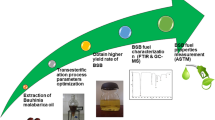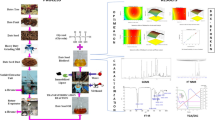Abstract
Transesterification of cottonseed oil was carried out using ethanol and potassium hydroxide (KOH). A central composite design with six center and six axial points was used to study the effect of catalyst concentration, molar ratio of ethanol to cottonseed oil and reaction temperature for percentage yield (% yield) and percentage initial absorbance (%A 385nm) of the biodiesel. Catalyst concentration and molar ratio of ethanol to cottonseed oil were the most significant variables affecting percentage conversion and %A 385nm. Maximum predicted % yield of 98% was obtained at a catalyst concentration of 1.07% (wt/wt) and ethanol to cottonseed oil molar ratio of 20:1 at reaction temperature of 25 °C. Maximum predicted %A 385nm of more than 80% was obtained at 0.5% (wt/wt) catalyst concentration and molar ratio of 3:1 at 25 °C. The response surfaces that described % yield and %A 385nm were inversely related. Gossypol concentration (% wt), oxidative stability and %A 385nm of biodiesel were found to be highly correlated with each other. Hence, color %A 385nm is a measure of the amount of pigments present in biodiesel fuels that have not yet been subjected to autoxidation. High gossypol concentration also corresponds to a fuel with high oxidative stability. The fatty acid ethyl esters (FAEE) produced from cottonseed oil had superior oxidative stability to fatty acid methyl esters (FAME) produced from cottonseed oil.




Similar content being viewed by others
References
O’Brien RD (2004) Fats and oils processing. In: Fats and oils: formulating and processing for application. CRC Press, Boca Raton, pp 16–18
Foglia TA, Nelson LA, Dunn RO, Marmer WN (1997) Low-temperature properties of alkyl esters of tallow and grease. J Am Oil Chem Soc 74:951–955
Knothe G (2005) Dependence of biodiesel fuel properties on the structure of fatty acid alkyl esters. Fuel Proc Technol 86:1059–1070
ASTM D 6751-07b (2007) Standard specification for biodiesel fuel blend stock (B100) for middle distillate fuels, American Society for Testing and Materials, West Conshohocken, PA
EN 14214-2003 (2003) Automotive fuels—fatty acid methyl esters (FAME) for diesel engines—requirement methods, European Committee for Standardization, Brussels, Belgium
Schuchardt U, Sercheli R, Vargas RM (1998) Transesterification of vegetable oils: a review. J Braz Chem Soc 9:199–210
Simoni MPM, Meneghetti MR, Wolf CR, Silva EC, Lima GES, Coimbra MA, Soletti JI, Carvalho SHV (2006) Ethanolysis of castor and cottonseed oil: a systematic study using classical catalysts. J Am Oil Chem Soc 83:819–822
AOCS official method ce 1-62 (1989) Fatty acid composition by gas chromatography. In: Official methods and recommended practices of the American Oil Chemist’s Society, AOCS Press, Champaign
Hron RJ, Kuk MS, Abraham G (1990) Determination of free and total gossypol by high performance liquid chromatography. J Am Oil Chem Soc 67:182–187
Bikou E, Louloudi A, Papayannakos N (1999) The effect of water on the transesterification kinetics of cottonseed oil with ethanol. Chem Eng Technol 22:70–75
Lima da Silva N, Maciel MRW, Batistella CB, Filho RM (2006) Optimization of biodiesel production from castor oil. App Biochem Biotechnol 130:405–414
Christie WW (1982) A simple procedure for rapid transmethylation of glycerolipids and cholesteryl esters. J Lipid Res 23:1072–1075
Gaita R (2006) A reversed phase HPLC method using evaporative light scattering detection (ELSD) for monitoring the reaction and quality of biodiesel fuels, Grace Davison discovery sciences: the application notebook, industrial 51. http://www.discoverysciences.com/WorkArea/downloadasset.aspx?id=5022
Reddy M, Narasinga Rao MS (1987) Effect of chemical modification on the binding of gossypol by gossypin (11S protein) and congossypin (7S protein) of cottonseed. J Bioscience 12:203–209
AOCS official method cd 12b-92 (1999) Oil stability index (OSI). In: Official methods and recommended practices of the American Oil Chemist’s Society, AOCS Press, Champaign
Freedman B, Pryde EH, Mounts TL (1984) Variables affecting the yields of fatty esters from transesterified vegetable oils. J Am Oil Chem Soc 61:1638–1643
Vicente G, Coteron A, Martinez M, Araci J (1997) Application of the factorial design of experiments and response surface methodology to optimize biodiesel production. Ind Crop Prod 8:29–35
Mason RL, Gunst RF, Hess JL (1989) Designs and analyses for fitting response surfaces. In: Statistic design and analysis of experiments: with applications to engineering and science, 2nd edn. Wiley, New York, pp 568–606
Benjamin IU, David OP, Kefas HM, Onche EO (2007) Determination of optimal catalyst concentration for maximum biodiesel yield from tigernut (Cyperus esculentus) oil. Leonardo J Sci 10:131–136
Zhou W, Boocock DGB (2006) Phase distribution of alcohol, glycerol, and catalyst in the transesterification of triglycerides. J Am Oil Chem Soc 83:1047–1050
Zhou W, Boocock DGB (2006) Phase behavior of the base-catalyzed transesterification of soybean oil. J Am Oil Chem Soc 83:1041–1045
Leung DYC, Guo Y (2006) Transesterification of neat and used frying oil: optimization for biodiesel production. Fuel Proc Technol 87:883–890
Acknowledgments
The authors are very grateful to Cotton, Incorporated and the United States Department of Agriculture for their financial support.
Author information
Authors and Affiliations
Corresponding author
About this article
Cite this article
Joshi, H.C., Toler, J. & Walker, T. Optimization of Cottonseed Oil Ethanolysis to Produce Biodiesel High in Gossypol Content. J Am Oil Chem Soc 85, 357–363 (2008). https://doi.org/10.1007/s11746-008-1200-7
Received:
Revised:
Accepted:
Published:
Issue Date:
DOI: https://doi.org/10.1007/s11746-008-1200-7




